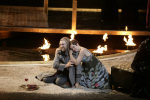Théâtre du Capitole, Toulouse
26th June 2005
« Pas un orchestre au monde n'a jamais surpassé celui de Mannheim pour ses exécutions. Son forte est un tonnerre, son crescendo une cataracte, son diminuendo un flot cristallin qui clapote dans le lointain, son piano un souffle printanier » : ainsi s'extasiait le musicographe Johann Adam Hiller sur l'orchestre considéré jusqu'en 1778 comme le meilleur par toute l'Europe musicienne et mélomane. C'est précisément pour la célèbre formation, protégée par l'Electeur Carl-Theodor IV von Pfalz-Sulzbach, qu'en 1771 Johann Christian Bach composerait Temistocle sur un livret que Pietro Metastasio avait écrit pour Antonio Caldara en 1736, dont l'adaptation au goût du jour, plus soucieux de cohérence dramaturgique et friand de légèreté formelle, fut confiée à Mattia Verazi, bien connu pour sa collaboration aux ouvrages de Jomelli, Holzbauer et Traetta. Temistocle sera créé dans l'un des plus vaste théâtre du temps, capable d'accueillir cinq mille personnes, à Mannheim, le 5 novembre 1772, et connaîtra un tel succès qu'il serait repris les 22 février, 5 et 20 novembre 1773. Outre les très estimés musiciens évoqués plus haut, l'opéra bénéficia d'une distribution regroupant des chanteurs réputés, à commencer par l'illustre Anton Raaf, ténor unanimement adulé en des années où les castrats avaient la préférence, et qui créerait neuf ans plus tard l'Idomeneo de Mozart.



Click on any picture to enlarge. All photographs © Patrice Nin
Coproduite par le Festival Bach, l'Opéra de Leipzig et le Théâtre du Capitole, la mise en scène tant raffinée qu'émouvante de Francisco Negrin gagnait cette semaine les planches toulousaines. L'ingénieux dispositif scénographique réalisé par Rifail Ajdarpasic et Ariane Isabell Unfried, véritable oasis de couleurs, d'eau et de plaisirs dans l'aridité de l'honneur du rôle-titre, invente une Perse onirique, hybridée de délicatesse nipponne, de sensualité maghrébine et de despotisme militaire moyen-oriental, qui se fait efficacement le reflet d'une situation – Temistocle qui demande asile à son ennemi – et d'une figure – l'inflexible Serse qui peu à peu devient souverain éclairé.
Dans une distribution équilibrée, on a principalement remarqué le sournois Sebaste généreusement sonore du contreténor Reno Troilus, le Neocle particulièrement soigné de Cecilia Nanneson, et l'attachante Aspasia à la vocalité facile de Ainhoa Garmendia. Il demeure regrettable que l'on ait choisi Rickard Söderberg pour le rôle-titre, un chanteur au timbre terne et parfois voilé qui manque du charisme nécessaire à un tel personnage. En revanche, on saluera bien bas la prestation de Marika Schönberg, Rossane époustouflante, avantagée par une couleur vocale extrêmement riche et un grand sens du théâtre. Au pupitre, Christophe Rousset, tout en soignant minutieusement les soli, comme le motif de clarinette d'amour et basson qui obsède le second mouvement de la sinfonia, par exemple, dirigeait ses Talens Lyriques dans une interprétation d'une tonicité excitante.
BB
Quick English translation by Alastair Disley
"No orchestra in the world ever surpassed that of Mannheim in its executions. Its forte is thunder, its crescendo a waterfall, its diminuendo a crystalline flood which laps into the distance, its piano a breath of Spring"
Thus the musicographer Johann Adam Hiller raptured on the orchestra considered the best until 1778 by all European musicians and music lovers. It was precisely for this famous formation, the protégée of l'Electeur Carl-Theodor IV von Pfalz-Sulzbach, that Johann Christian Bach composed Temistocle in 1771 based on a text that Pietro Metastasio had written for Antonio Caldara in 1736. The adaptation to the style of that day, concerned with dramatic coherence and fond of delicacies of formal lightness, was entrusted to Mattia Verazi, well-known for his collaborations with the works of Jomelli, Holzbauer and Traetta. Temistocle was first presented in Mannheim in one of the largest theatres of the time, able to accomodate five thousand people, on November 5th 1772, and was such a success that it was reprised on February 22nd, November 5th and 20th, 1773. In addition to the esteemed musicians mentioned above, the opera benefited from a gathering together of well-reputed singers, beginning with the illustrious Anton Raaf, a unanimously adulated tenor in the years when castrati were prefered, and who nine years later would be Mozart's Idomeneo.
Co-produced by the Bach Festival, the Opera of Leipzig and the Théâtre du Capitole, the Toulouse boards this week gained the refined scene-setting of Francisco Negrin. The scenic devices realised by Rifail Ajdarpasic and Ariane Isabell Unfried were clever - a veritable oasis of colors, water and pleasures in the aridity of the honor of the title role, inventing an honorary Perse, a hybrid of Japanese delicacy, Moroccan sensuality and middle-Eastern military despotism, which effectively reflects the situation - Temistocle who claims asylum from his enemy - and a figure - the inflexible Serse who little by little becomes an enlightened sovereign.
In a balanced production, one mainly noticed the underhand Sebaste, liberally sung by counter-tenor Reno Troilus, Cecilia Nanneson's particularly neat Neocle, and the matching of Aspasia with the easy vocality of Ainhoa Garmendia. It remains regrettable that Rickard Söderberg was chosen for the title role, a singer with a dull and somewhat veiled timbre who lacked the charisma necessary for such a character. On the other hand, one gladly salutes the services of Marika Schönberg, a staggering Rossane, favoured by an extremely rich vocal color and a great sense of theatre. At the music desk, Christophe Rousset, always took care with the soloists, for example the motif of clarinette d'amour and bassoon which fills the second movement of the sinfonia, directing his "Talens Lyriques" in an interpretation of an exciting tonicity.
BB
